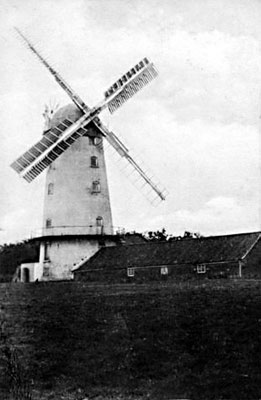
|
Roughton
Mill Hill towermill |
 |
|
c.1905
|
Roughton Mill Hill tower mill was probably built in 1814 when Robert Bourne Joy took the business over from his mother and it has a datestone inscribed RB Joy 1814 set above the stage door on the second floor. The site had earlier been occupied by two postmills that had stood together on the site - an earlier_mill and a later_mill.
|
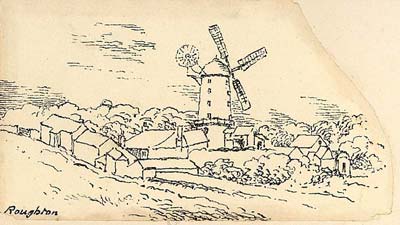 |
Sketch c.1890 |
The six storey red brick tower with its stage around the second floor was originally painted white but reverted to plain red brick in later years. The mill tower was only 56 feet high and had a domed cap, an eight bladed fan and three pairs of stones powered by four double shuttered sails each with ten bays of three shutters.
|
ROUGHTON MILLS |
The WIDOW of the late Robert Joy, Miller, having carried on business since her Husband's decease, intends giving up the same on 22nd April next and begs leave to return her most grateful thanks to her Friends for past favours conferred upon her and solicits a continuance of the same on behalf of her son Robert B. Joy, who will succeed her in the above business. All persons to whom the said Widow stands indebted are requested to send their accounts in order that they may be discharged; likewise all persons who are indebted to her are requested to settle the same by the 22nd April next. Norfolk Chronicle - 26th March 1814 |
Robert Joy snr died on 20th September 1794 aged 40 and his wife Mary Joy carried on running the business for the next twenty years with Robert snr's younger brother, Edmund Joy, managing the business for her. She remained living with her son Robert jnr at the Mill House. The lease expired in 1814 and Mary Joy then sold the business to her son Robert Bourne Joy. |
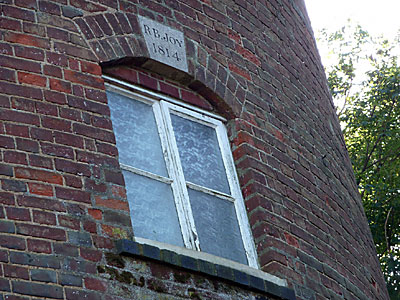 |
|
1814 datestone above the first floor window - 12th October 2008 |
Faden's map of 1797 only shows one postmill and almost immediately upon taking over, Robert Joy demolished the remaining postmill and built a new towermill on the same site. It is probable that Edmund Joy remained working at the new mill as a brick near the west door bears the inscription E. Joy 1814. |
Robert Joy snr died in Roughton on 20th September 1794. aged 40. Edmund Joy was born c.1756 and died in Roughton on 14th July 1833 aged 77. Mary Joy died on 17th October 1847 at the age of 93 and her son Robert Bourne Joy died on 8th September December 1863 aged 71. |
When Robert Joy died his daughter Sarah continued to run the mill and the farm until she put the mill up for sale or let in 1867. |
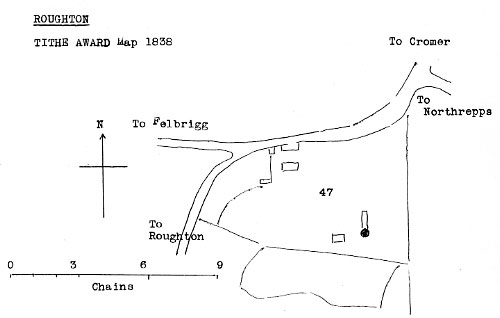 |
Tithe map 1838 - as redrawn by Harry Apling |
Tithe Award 1841 |
||||
No. 47 |
House, Mill & Buildings |
|
3a. 3r. 31p. |
8/6 Vic. |
ROUGHTON MILL |
To be SOLD or LET, all that substantially Brick-built TOWER WIND MILL well situated at Roughton, within two Miles of Cromer, Norfolk, driving Three Pairs of Stones, with Patent Sails, seven Floors and capable of grinding on an average six Lasts per week, Granaries capable of stowing 60 Lasts of corn. Also a good Dwelling house... Piece of excellent Pasture Ground, the whole with sites of buildings containing four Acres. All Freehold. The above Premises are well adapted for carrying on a very extensive and profitable business and immediate possession may be had. Apply to Messrs. Keith, Blake, Kent & Co., Solicitors, Norwich or to Henry Sandford, Estate Agent, Cromer. Norfolk Chronicle & Norfolk News - 24th August, 7th & 14th September 1867 |
H. SANDERSON & SON have received instructions to Sell by Auction on Friday 9th October 1868 Three very powerful Draught Horses, Two Riding Horses, Miller's Carts, Harness etc., Outdoor effects and part of the HOUSEHOLD FURNITURE on the premises at Roughton Mill. |
ROUGHTON near Cromer |
Frank Brown, who came to the mill c.1871 was born in Itteringham, where his father James Brown, was miller, farmer and maltster. |
Situations Vacant |
To Millers |
Notice re John Leman late of Roughton, Miller, deceased. |
ROUGHTON, Norfolk |
| The Press family also owned the Yarmouth Southtown High Mill and when that mill was demolished in 1904, its sails were transported to Roughton and fitted to the towermill. |
Around 5.00am on Monday 17th September 1906 a strong northeasterly gale tailwinded the mill making the sails revolve fast in reverse. The massive amount of heat caused by the resulting friction set the mill on fire and despite the best attempts of the Cromer Fire Brigade, the mill was destroyed just leaving the tower shell. The granary survived but was later demolished. |
News item from an unnamed source:- |
|
| Wednesday September 19, 1906 | "DUSTY" |
| ... there was an internal combustion engine in the Roughton mill (this might have operated from a suction producer using coal, peat or even sawdust) ... | |
| Milling - August 1969 | |
Roughton Mill, 17th September 1906 |
GALE SCENES AT CROMER |
A strong north-easterly gale was experienced at Cromer during Sunday night; and between five and eight a.m. yesterday the services of the Fire Brigade and the Rocket Brigade and the lifeboat were requisitioned. At the earlier hour the Fire Brigade under Captain J. K. Frost was summoned to Roughton Mill, some three miles distant, which was in flames. They could do nothing to save the mill, which was completely destroyed. The origin of the fire was due to the gale setting the sails at work, the friction thus generated soon causing the whole structure to burst into flame. The mill was the property of the Bond-Cabbell trustees and Mr. Press was the tenant. The mill stood very high and both from sea and land was very conspicuous for many miles. It was an old structure, dating as far back as 1814. The sight of the conflagration at that hour of the morning was described by an eye witness as truly magnificent. When the brigade reached the spot the fire had already got too great a hold and the was nothing more nor less than a pile of lurid flames. Fortunately it was found possible to save the granary, nor did the adjacent heath catch alight, as, at one time, was feared would be the case. The sparks from the burning structure went high up and spent themselves before their fall. Mr. Press, who lives in the Mill House, is we understand insured in the Norwich Union Office. A lady visitor in the house appears to have been to have been the first to have been awakened by the terrific noise caused by the sails revolving the reverse way at an ever increasing velocity until the friction thus caused resulted in one tower of flame. At about the same hour the Rocket Brigade under Captain Frank H. Barclay were called out by the coastguard ... ... lifeboat launched at eight o'clock ... Eastern Daily Press - Tuesday 18th September 1906 |
Roughton Mill was destroyed by fire on the 17th. ult., caused by a heavy gale releasing the gripes and starting the sails in the reverse direction, when the friction quickly set up a blaze. This mill stood three miles from Cromer and formed a well-known landmark, having dated from 18147. It was found impossible by the Cromer Fire Brigade to save the mill, but they prevented the extension of the flames to the granary. |
Soon after the fire, Frederick William Press and his family emigrated to New Westminster in British Columbia, Canada.
|
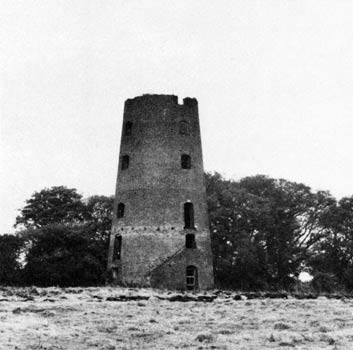 |
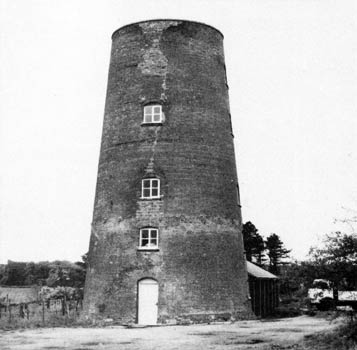 |
26th May 1970 |
19th May 1981 |
When the refronted guttering was removed the date 1778 was found on the cistern. On the road side side of the outbuilding, the inscription R. Joy 1774 was found, this being the date Robert Joy took over the postmill. |
Work commenced on renovating the tower during 1978 for use as the headquarters of the local scout group and a new building was erected adjoining the mill following the same lines as the old granary. The foundation stone was laid by the Chief Scout, Sir William Gladstone on Sunday 9th July, 1978 |
Mr. A. J. Thrower, Great Yarmouth Millwright who worked on the High Mill (Southtown, Yarmouth) etc. told me in 1951, "The Sails from the High Mill were fitted to Roughton Mill, so she must have been very powerful." |
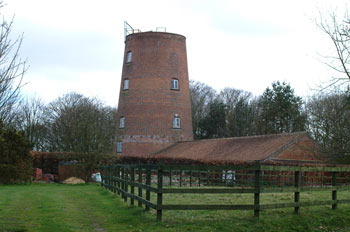 |
|
6th
April 2003
|
1st Rural Scout Group is hoping to repair mill for use as their Headquarters. |
A SCOUT group's future looks to be secure after a successful appeal to buy their headquarters in an old windmill. The plea for funds by the First Rural Scouts, launched last July, has raised almost £227,000 to buy Roughton Mill, near Cromer. |
Major Anthony Gurney of Manor Farm Northrepps, was instrumental in the raising of the £200,000 necessary to buy the mill. |
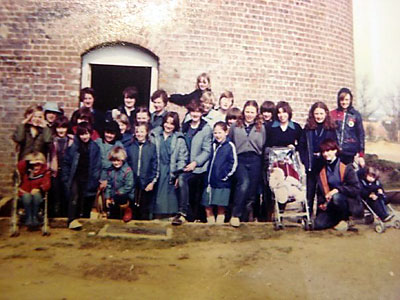 |
|
1st Wanstead Guide Company 1982 |
This was taken Easter 1982 or 3 and is of the 1st Wanstead Guide Company. We stayed for a week and had a fabulous time. Inside seemed so huge and I remember us all around the walls in our sleeping bags. I remember we went to the beach and saw a seal which for city girls was quite an amazing sight! We also went on the steam train at Sheringham and I have a photo of that somewhere which I'll try to find! One of our Guiders moved up to Norfolk and I often wonder if it was this camp that made her want to move. |
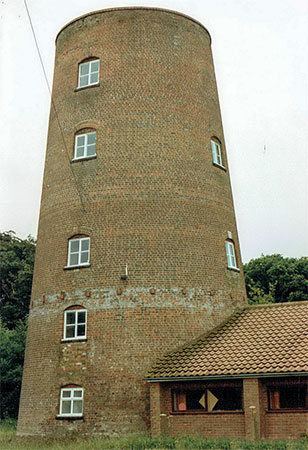 |
|
1990 |
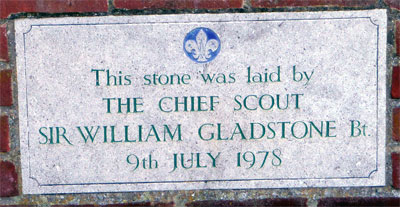 |
|
12th October 2008 |
Datestone on new building erected on the site of the old granary. |
The stone above the window "RB JOY 1814" is not the original. When the mill was renovated in the 1970s for the Scouts, the original stone was broken - whether by the fire or just age. An identical replica was made and replaced into the arch when the windows were replaced (1977). The original stone is now set in the wall on the ground floor, inside the tower. |
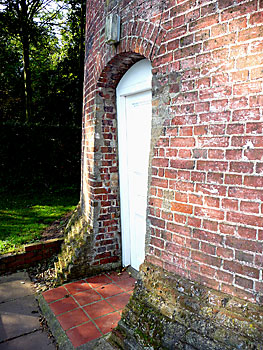 |
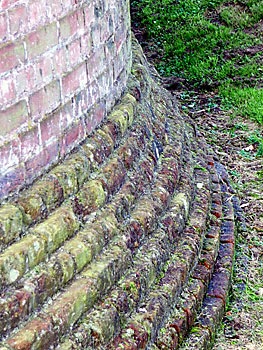 |
|
Mill doorway and stepped skirt 12th October 2008 |
|
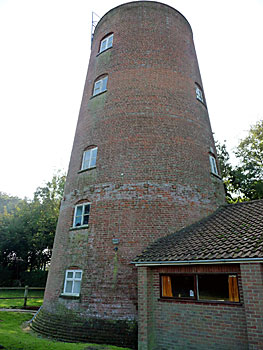 |
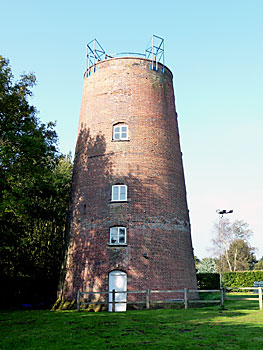 |
|
12th October 2008 |
12th October 2008 |
Robert Copeman of Itteringham, had a daughter who married into the Spurrell family. |
The Spurrells were related by marriage to the Joys, who owned Roughton Mill in the 18th and 19th centuries. When the last Joy died in the 1860s the mill passed to Daniel Spurrell, who later sold it to Benjamin Bond Cabbell of Cromer Hall. |
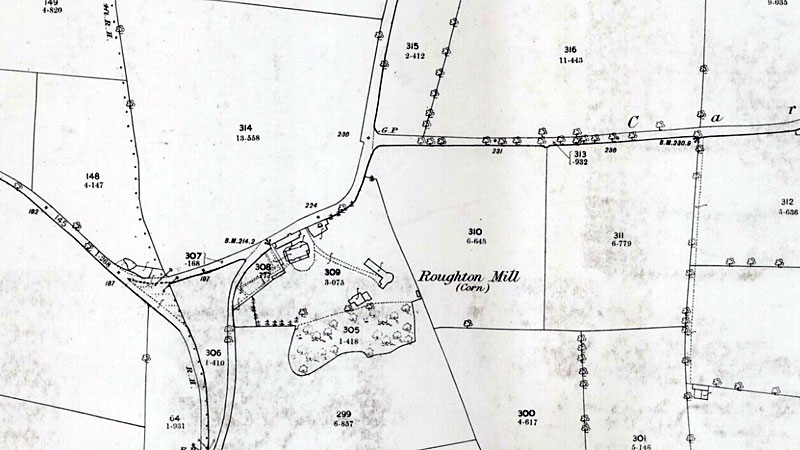 |
O. S. Map 1885 Courtesy of NLS map images |
White's 1854: John Leman, foreman miller (either this mill or Chapel Road towermill) |
| 20th September 1794: Robert Joy snr died at the age of 40
(born 1754) 1814: Robert Bourne Joy jnr took over the postmill and business from his mother, Mary Joy 1814: Towermill built on site of postmills Bryant's map 1826: Routon Mill Poll Book 1832: Robert B. Joy, miller 14th July 1833: Edmund Joy died aged 77 (born 1756) Index of Wills 1836: Edmund Joy, miller White's 1836: Robert Bourne Joy, corn miller O.S. map 1838: Windmill
Tithe Award 1841: Owner & occupier : Robert Bourn Joy Poll Book 1841: Robert Jay, miller 15th January 1843: Mary Copeman (2nd daughter of Robert & Mary Joy) aged 51 (born 1791) White's 1845: Robert Bourne Joy, corn miller 17th October 1847: Mary Joy died aged 93 (born 1754)
White's 1854: Robert B. Joy, corn miller Tower mill
8th September 1863: Robert Bourne Joy died aged 71 (born 1792) White's 1864: Sarah Ivy, farmer & corn miller 1867: Sarah Ivy (Joy) died aged 74 (born 1793) 1867: Mill advertised to be sold or let September 1868: Business & household effects advertised for sale by auction
c.1871-1879: Frank Brown 1876: John Leman, journeyman miller, died Harrod's 1877: Frank Brown, miller & merchant Kelly's 1879: Frank Brown, miller 1881: Frank Brown, miller, left the mill June 1881: Mill advertised to be let White's 1883: Edward Harvey, miller & farmer 1888: Edward Albert Press White's 1890: Press Bros., millers; and at Cromer, Yarmouth and North Walsham Kelly's 1892: Press Brothers, millers (wind) (also at High Mill and Green Cap Mill, Southtown, Gt. Yarmouth) Kelly's 1896: Press & Pallett, millers (wind); & at North Walsham & Cromer Kelly's 1900: Press & Pallett, millers (wind); & at North Walsham & Cromer 1904: Mill owned by Bond-Cabbell Trustees (Cromer) Kelly's 1904: Frederick William Press, miller & merchant Monday 17th September 1906: Mill tailwinded and then destroyed by fire Kelly's 1908: Misses Ada & Bessie Fox, Private Nursing Home, Roughton Mill Kelly's 1912: Misses Ada & Bessie Fox, Private Nursing Home, Roughton Mill
1933: Miss Mills, Mill House 1937: Miss Mills, Old Mill House 1978: Brigadier Philip Henry Cecil Hayward CBE & Mrs. Diana Hayward, Old Mill House March 1978: Work commenced on renovating the mill for use by North Norfolk District 1st Rural Scout Group Sunday 9th July 1978: Chief Scout, Sir William Gladstone, Bt., laid the foundation stone for new Scout HQ 5th July 1983: Brigadier Philip Henry Cecil Hayward CBE, died 2005: Mill headquarters for North Norfolk District 1st Rural Scout Group 2008: Scout group purchased mill for £200,000 on expiry of the 30 year lease of 1978 |
If you have any memories, anecdotes or photos please let us know and we may be able to use them to update the site. By all means telephone 07836 675369 or
|
| Nat Grid Ref TG21623923 | Copyright © Jonathan Neville 2005 |